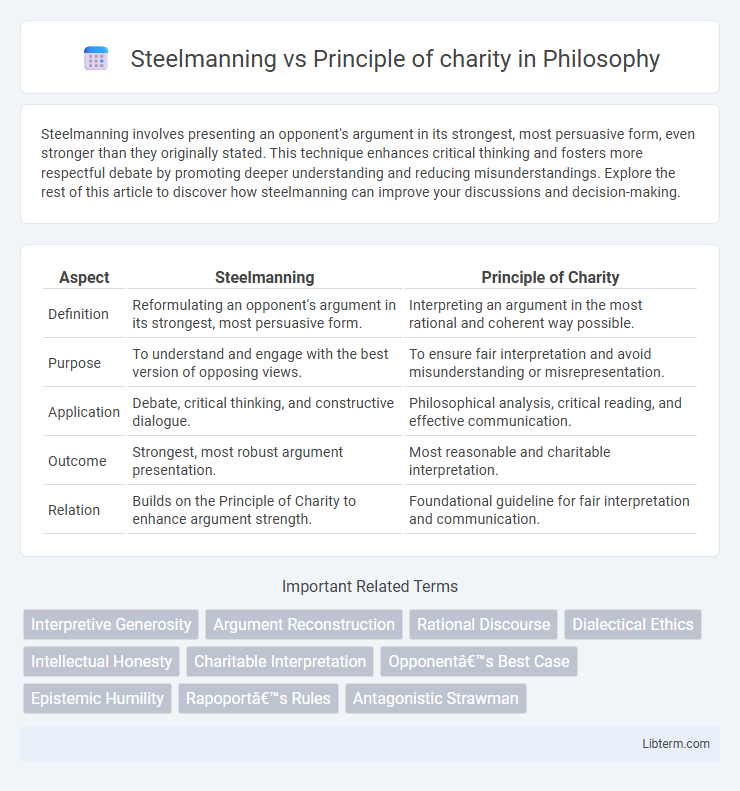Steelmanning involves presenting an opponent's argument in its strongest, most persuasive form, even stronger than they originally stated. This technique enhances critical thinking and fosters more respectful debate by promoting deeper understanding and reducing misunderstandings. Explore the rest of this article to discover how steelmanning can improve your discussions and decision-making.
Table of Comparison
| Aspect | Steelmanning | Principle of Charity |
|---|---|---|
| Definition | Reformulating an opponent's argument in its strongest, most persuasive form. | Interpreting an argument in the most rational and coherent way possible. |
| Purpose | To understand and engage with the best version of opposing views. | To ensure fair interpretation and avoid misunderstanding or misrepresentation. |
| Application | Debate, critical thinking, and constructive dialogue. | Philosophical analysis, critical reading, and effective communication. |
| Outcome | Strongest, most robust argument presentation. | Most reasonable and charitable interpretation. |
| Relation | Builds on the Principle of Charity to enhance argument strength. | Foundational guideline for fair interpretation and communication. |
Introduction to Steelmanning and Principle of Charity
Steelmanning involves reconstructing an opponent's argument in its strongest, most persuasive form, ensuring fair representation beyond mere criticism. The Principle of Charity emphasizes interpreting statements in the most rational and coherent way possible, aiming to avoid misunderstandings and misrepresentations. Both concepts promote intellectual honesty by encouraging fair and accurate engagement with differing viewpoints.
Defining Steelmanning: Beyond the Strawman
Steelmanning involves reconstructing an opponent's argument in its strongest, most persuasive form, ensuring clarity and intellectual honesty in debate. Unlike the Principle of Charity, which aims to interpret statements in the most reasonable way to avoid misrepresentation, steelmanning goes further by enhancing the argument to its best possible version. This approach promotes constructive dialogue and deeper understanding by engaging with the most robust version of opposing viewpoints.
Unpacking the Principle of Charity
The Principle of Charity involves interpreting another person's argument in its strongest, most coherent form to fairly assess its validity and avoid misrepresentation. Steelmanning extends this by actively reconstructing the argument in the most persuasive and robust way possible, often improving upon the original presentation. Unpacking the Principle of Charity reveals its role in fostering constructive dialogue by prioritizing clarity, fairness, and intellectual generosity in understanding opposing perspectives.
Historical Origins of Both Concepts
Steelmanning and the Principle of Charity both originate from traditions in philosophy aimed at improving argumentative clarity and fairness, with the Principle of Charity tracing back to 17th-century thinkers like Charles S. Peirce who emphasized interpreting arguments in their strongest form to avoid misunderstanding. Steelmanning, a more recent concept popularized in the 20th and 21st centuries, builds on this foundation by actively reconstructing opponents' arguments in their most persuasive and robust version. Both principles share roots in Socratic dialectics and critical reasoning methodologies that emphasize intellectual honesty and constructive dialogue.
Key Differences Between Steelmanning and the Principle of Charity
Steelmanning involves reconstructing an opponent's argument in its strongest, most persuasive form to ensure fair representation and rigorous debate, while the Principle of Charity mandates interpreting ambiguous statements in the most rational and coherent way possible. Steelmanning seeks to enhance the original argument by improving its clarity and strengths, whereas the Principle of Charity primarily aims to avoid misunderstandings and attribute truth to a speaker's intent. Both concepts promote intellectual honesty, but steelmanning actively improves arguments beyond their initial presentation, contrasting with the Principle of Charity's focus on charitable interpretation.
Benefits of Practicing Steelmanning in Debates
Steelmanning enhances debates by encouraging the strongest possible articulation of opposing arguments, promoting deeper understanding and reducing misinterpretations. This practice fosters intellectual humility and constructive dialogue, leading to more informed and balanced decisions. Emphasizing steelmanning cultivates respect among participants and elevates the overall quality of discourse.
The Role of the Principle of Charity in Productive Dialogue
The Principle of Charity plays a crucial role in productive dialogue by encouraging interpreters to present others' arguments in their strongest and most coherent form, fostering mutual understanding and reducing miscommunication. Steelmanning, a practical application of this principle, involves reconstructing opposing views in their most persuasive and rational version, thereby promoting respect and collaborative problem-solving. Together, these concepts enhance constructive discourse by shifting focus from winning arguments to genuinely engaging with ideas on their best terms.
Common Misconceptions About Both Approaches
Steelmanning is often mistaken for simply restating an argument more charitably, but it involves reconstructing the strongest possible version of the opposing stance, often exceeding the original presentation. The Principle of Charity is commonly misunderstood as always interpreting arguments in the most favorable light, while it specifically requires interpreting statements to make them logically coherent and rational. Both approaches are frequently confused, though steelmanning actively strengthens arguments, whereas the Principle of Charity aims to avoid straw-manning by ensuring fair interpretation.
Practical Examples: Steelmanning vs Principle of Charity
Steelmanning involves reconstructing an opponent's argument in its strongest, most persuasive form, often exceeding their original presentation to promote deeper understanding and productive debate. The Principle of Charity requires interpreting statements in their most reasonable and rational way, avoiding misrepresentation or straw-manning to ensure fair engagement. For example, in a political debate, steelmanning might reframe a weak economic critique into a comprehensive policy proposal to encourage constructive dialogue, while the Principle of Charity would clarify ambiguous statements to their most logical meaning, preventing misunderstandings.
Choosing the Right Approach for Effective Communication
Steelmanning involves reconstructing an opponent's argument in its strongest possible form to foster constructive dialogue, while the principle of charity focuses on interpreting statements in the most rational and coherent way. Choosing between these approaches depends on the communication context: steelmanning is ideal for debates aiming at mutual understanding and progress, whereas the principle of charity ensures fair interpretation in everyday conversations and academic discussions. Employing the appropriate method enhances clarity, reduces misunderstandings, and promotes effective and respectful communication.
Steelmanning Infographic

 libterm.com
libterm.com